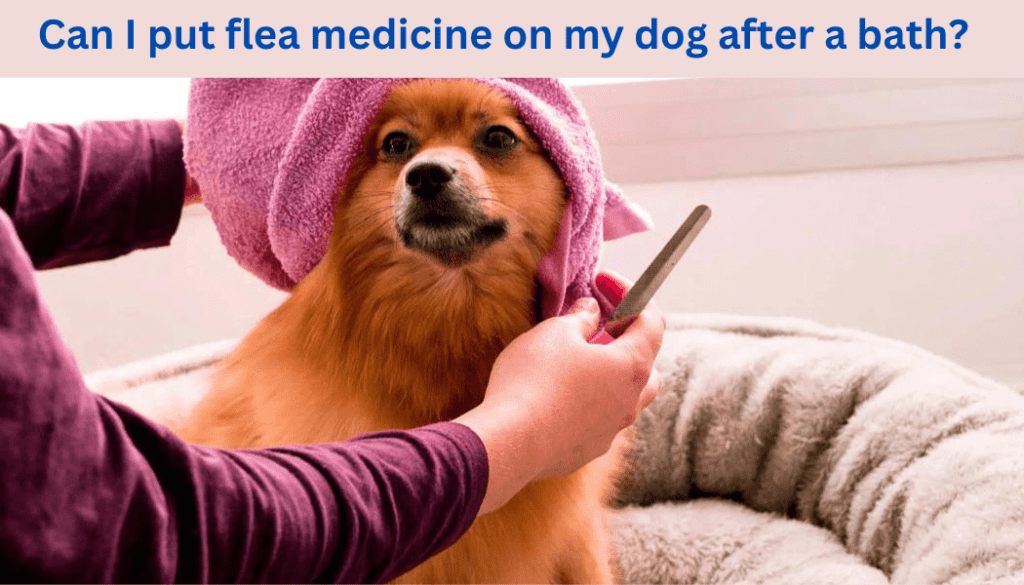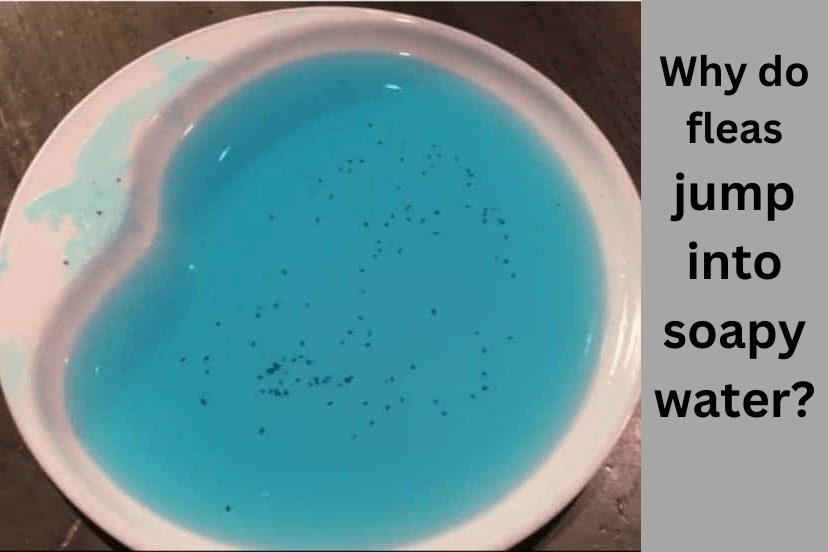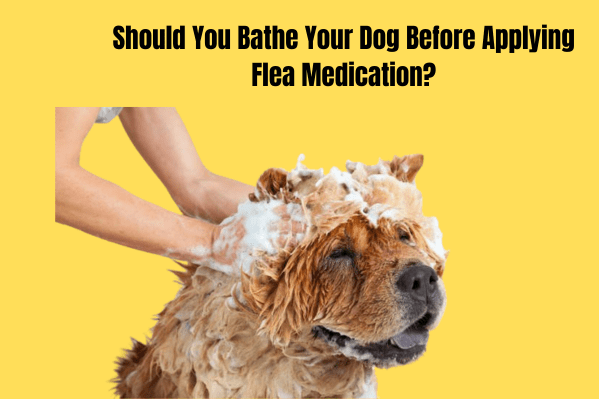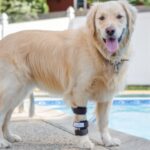Frontline is a popular and effective flea and tick treatment for dogs. It works by killing the parasites that infest your dog’s skin and coat and preventing new ones from attaching. Frontline is easy to apply: you just need to squeeze the contents of a pipette onto the skin between your dog’s shoulder blades, where they can’t lick it off.
However, should you bathe your dog before applying flea medication? Many dog owners have questions and concerns about how bathing affects the performance and safety of Frontline. In this article, we will answer some of the most common questions and provide some tips on how to bathe your dog without compromising the effectiveness of Frontline.
Contents
- 1 Should I bathe my dog before applying to Frontline?
- 2 To keep your dog’s coat clean and healthy
- 3 How long before flea treatment can I bathe my dog?
- 4 Can I use flea shampoo and flea medicine together?
- 5 Can I put flea medicine on my dog after a bath?
- 6 Can I bathe my dog with a flea collar on?
- 7 Does Frontline need to be reapplied after a bath?
- 8 Do fleas go away after a flea bath?
- 9 Can fleas be killed with shampoo?
- 10 Why do fleas jump into soapy water?
- 11 Conclusion
Should I bathe my dog before applying to Frontline?
It is not necessary to bathe your dog before applying Frontline, as long as your dog’s coat is clean and dry. Bathing your dog before applying Frontline can have some drawbacks, such as:
- Reducing the effectiveness of Frontline. Bathing can remove some of the natural oils from your dog’s skin and coat, which helps Frontline spread and adhere to the hair follicles. This can make Frontline less potent and shorten its duration of action.
- Causing skin irritation. Bathing can also dry out your dog’s skin and make it more sensitive to the alcohol-based solution of Frontline. This can cause itching, redness, or inflammation at the application site.
To keep your dog’s coat clean and healthy
If you want to keep your dog’s coat clean and healthy without bathing, you can try some of these tips:
- Brush your dog regularly. This will help remove dirt, debris, and loose hair from your dog’s coat, and stimulate blood circulation and oil production in the skin. Brushing can also help distribute Frontline evenly throughout your dog’s coat after application.
- Wipe your dog with a damp cloth or a pet wipe. This will help remove any surface dirt or odors from your dog’s coat, and keep it fresh and shiny. Wiping can also help remove any excess Frontline from your dog’s fur, which can prevent accidental ingestion by your dog or other pets.
- Use a dry shampoo or a spray conditioner. This will help clean and moisturize your dog’s coat without using water or soap. Dry shampoo or spray conditioner can also help deodorize and detangle your dog’s fur, and add some shine and softness to it.
How long before flea treatment can I bathe my dog?
It is recommended to wait at least 48 hours after applying Frontline before bathing your dog. This is because Frontline needs some time to fully absorb into your dog’s skin and coat, and form a protective barrier against fleas and ticks. Bathing your dog too soon after applying Frontline can reduce its efficacy or wash it off completely, leaving your dog vulnerable to re-infestation. Some of the reasons why bathing can affect Frontline are:
- Diluting or removing Frontline. Bathing can dilute or rinse off some of the active ingredients of Frontline from your dog’s skin and coat, especially if you use a harsh or medicated shampoo. This can lower the concentration and coverage of Frontline, and make it less effective against fleas and ticks.
- Disrupting the distribution of Frontline. Bathing can also disrupt the natural distribution of Frontline throughout your dog’s coat, which depends on the movement and grooming of your dog. Bathing can cause some areas of your dog’s coat to have more or less Frontline than others, creating gaps or overlaps in the protection.
If you need to clean your dog during the 48 hours after applying Frontline, you can use some of these alternatives to bathing:
- Use a damp cloth, a spray bottle, or a mild wipe to clean your dog’s face, paws, and genitals. These are the areas that tend to get dirty or smelly more often, and need more frequent cleaning. You can use plain water or a gentle cleanser to wipe these areas, and avoid touching the application site of Frontline.
- Use a flea comb or a lint roller to remove any dead fleas or flea dirt from your dog’s coat. This will help prevent any secondary infections or allergic reactions caused by flea bites or feces. Flea combing or lint rolling can also help monitor the effectiveness of Frontline, and alert you to any signs of resistance or re-infestation.
Suggested: Why A Dog Can’t Eat Onion?
Can I use flea shampoo and flea medicine together?
It is not advisable to use flea shampoo and flea medicine together, as they can interfere with each other’s actions or cause adverse reactions. Flea shampoo and flea medicine are both designed to kill fleas and ticks, but they work in different ways and have different ingredients. Using them together can have some negative consequences, such as:
- Reducing the effectiveness of flea medicine. Flea shampoo can wash off or neutralize some of the active ingredients of flea medicine, making it less potent and durable. Flea shampoo can also leave a residue on your dog’s skin and coat, which can prevent flea medicine from absorbing or spreading properly.
- Causing adverse reactions. Flea shampoo and flea medicine can both have side effects, such as skin irritation, hair loss, vomiting, or seizures. Using them together can increase the risk or severity of these side effects, especially if your dog is allergic or sensitive to any of the ingredients. Flea shampoo and flea medicine can also interact with each other or with other medications that your dog is taking, causing unwanted or dangerous effects.
If you want to choose the best flea treatment for your dog, you should consider some of these factors:
- The severity of the infestation. If your dog has a mild or moderate infestation, you may only need to use one type of flea treatment, such as flea medicine or flea shampoo. If your dog has a severe or chronic infestation, you may need to use a combination of flea treatments, such as flea medicine and flea collar, or flea medicine and flea spray. However, you should always consult your veterinarian before using multiple flea treatments, and follow the instructions and precautions carefully.
- The age and weight of your dog. Some flea treatments are not suitable for puppies, senior dogs, or dogs that are underweight or overweight. These dogs may have weaker immune systems or different metabolisms, which can affect how they respond to flea treatments. You should always check the label and dosage of flea treatments, and make sure they are appropriate for your dog’s age and weight. You should also weigh your dog regularly, and adjust the dosage accordingly.
- Your veterinarian’s advice. Your veterinarian is the best person to advise you on the best flea treatment for your dog, based on your dog’s medical history, health condition, and lifestyle. Your veterinarian can also prescribe or recommend flea treatments that are more effective, safer, or cheaper than the ones available over the counter. You should always follow your veterinarian’s advice, and report any problems or questions that you have about flea treatments.
Can I put flea medicine on my dog after a bath?
It is possible to put flea medicine on your dog after a bath, as long as your dog’s coat is completely dry. Putting flea medicine on your dog after a bath can have some benefits, such as:
- Ensuring a better distribution of flea medicine. Bathing can help remove any dirt, grease, or debris from your dog’s skin and coat, which can interfere with the absorption or spread of flea medicine. Bathing can also help detangle and smooth your dog’s fur, which can make it easier to apply flea medicine and ensure a more even coverage.
- Providing a longer-lasting protection. Bathing can help remove any dead skin cells, loose hair, or old flea medicine from your dog’s coat, which can reduce the effectiveness or duration of flea medicine. Bathing can also help hydrate and nourish your dog’s skin and coat, which can improve the health and immunity of your dog against fleas and ticks.

However, you should also take some precautions when putting flea medicine on your dog after a bath, such as:
- Avoid contact with the eyes and mouth. Flea medicine can be harmful if it gets into your dog’s eyes or mouth, causing irritation, inflammation, or poisoning. You should avoid applying flea medicine near your dog’s eyes or mouth, and use a cotton ball or a dropper to apply it carefully. You should also wash your hands thoroughly after applying flea medicine, and keep your dog from licking or rubbing the application site.
- Wearing gloves. Flea medicine can also be harmful if it gets into your skin, causing rash, itching, or allergic reaction. You should wear gloves when applying flea medicine, and dispose of them properly after use. You should also avoid touching your face, eyes, or mouth while wearing gloves, and wash your clothes and bedding after handling flea medicine.
- Keep your dog away from children and other pets until the product is dry. Flea medicine can be transferred from your dog’s coat to other surfaces or animals, causing exposure or ingestion. You should keep your dog away from children and other pets until the flea medicine is dry, which can take up to 24 hours. You should also avoid letting your dog sleep on your bed or couch, or play with toys or chewables until the flea medicine is dry.
Can I bathe my dog with a flea collar on?
It is not recommended to bathe your dog with a flea collar on, as it can reduce the effectiveness of the collar or cause skin irritation. Some of the reasons why bathing your dog with a flea collar on can be problematic are:
- Exposing your dog to harmful chemicals. Bathing your dog with a flea collar on can cause the chemical in the collar to leach out or dissolve in the water, and get into your dog’s eyes, mouth, or skin. This can irritate or harm your dog, and cause symptoms such as redness, itching, swelling, or vomiting.
- Damaging the collar. Bathing your dog with a flea collar on can also damage the collar, and make it less durable or functional. The water can weaken the material of the collar, and make it more prone to breaking or tearing. The water can also wash away or dilute the chemical in the collar, and make it less potent or effective against fleas and ticks.
- Choking your dog. Bathing your dog with a flea collar on can also pose a choking hazard for your dog, especially if the collar is too loose or too tight. The water can make the collar slip or tighten around your dog’s neck, and restrict their breathing or blood flow. The water can also make the collar more attractive or accessible for your dog to chew or swallow, and cause choking or intestinal blockage.
If you want to use a flea collar safely and effectively, you should follow some of these tips:
- Follow the manufacturer’s instructions. Different flea collars may have different guidelines on how to use them, and how often to bathe your dog with them. You should always read and follow the instructions that come with the collar, and contact the manufacturer or your veterinarian if you have any questions or doubts.
- Check the fit regularly. You should always make sure that the flea collar fits your dog properly, and adjust it as needed. The collar should be snug but not tight, and you should be able to fit two fingers between the collar and your dog’s neck. You should also check the collar for any signs of wear and tear, and replace it if it is damaged or expired.
- Remove the collar before bathing. The best way to avoid any problems with bathing your dog with a flea collar on is to remove the collar before bathing. You should take off the collar and store it in a dry and safe place and put it back on after your dog is completely dry. This will prevent any exposure, damage, or choking risks, and ensure the optimal performance of the collar.
Does Frontline need to be reapplied after a bath?
It is not necessary to reapply Frontline after a bath, as the product is waterproof and remains effective for up to 30 days. Frontline is a topical flea and tick treatment that works by penetrating your dog’s skin and hair follicles and killing the parasites that bite your dog. Frontline is resistant to water and shampoo and does not wash off or lose its efficacy after bathing.
However, there are some exceptions to this rule, such as:
- If your dog is bathed more than once a week. Frequent bathing can reduce the amount or duration of Frontline on your dog’s skin and coat, and make it less effective against fleas and ticks. If you need to bathe your dog more than once a week, you should consult your veterinarian about the best way to maintain your dog’s flea and tick protection.
- If your dog is exposed to harsh chemicals or detergents. Some chemicals or detergents can interfere with the action or absorption of Frontline, and make it less potent or durable. If your dog is exposed to these substances, such as bleach, chlorine, or vinegar, you should rinse your dog thoroughly with water, and reapply Frontline as soon as possible.
If you want to maintain your dog’s flea and tick protection, you should follow some of these reminders:
- Apply Frontline monthly. You should apply Frontline to your dog every month, or as directed by your veterinarian, to ensure continuous and effective protection against fleas and ticks. You should apply Frontline on the skin between your dog’s shoulder blades, where they can’t lick it off, and avoid touching or rubbing the application site until it is dry.
- Check your dog for signs of infestation. You should regularly check your dog for any signs of flea or tick infestation, such as scratching, biting, licking, hair loss, or scabs. You should also look for any fleas, ticks, or flea dirt on your dog’s coat, skin, or bedding. If you notice any of these signs, you should treat your dog and your environment as soon as possible.
- Treat your home and yard for fleas and ticks. You should also treat your home and yard for fleas and ticks, as they can survive and reproduce in these areas, and re-infest your dog. You should vacuum and wash your dog’s bedding, furniture, and carpets, and apply a flea spray or fogger to your home and yard. You should also keep your grass and bushes trimmed, and remove any debris or clutter that can harbor fleas and ticks.
Do fleas go away after a flea bath?
A flea bath alone is not enough to get rid of fleas, as it only kills the adult fleas on your dog, but not the eggs, larvae, and pupae in the environment. Fleas have a complex life cycle and can survive and multiply in various stages and places. A flea bath can only eliminate a small fraction of the flea population, and leave your dog vulnerable to re-infestation.
To eliminate fleas, you need to take some additional steps, such as:
- Use an effective flea treatment. You should use an effective flea treatment, such as Frontline, that can kill not only the adult fleas, but also the eggs, larvae, and pupae on your dog. You should apply the flea treatment according to the instructions, and repeat it as needed to break the flea life cycle and prevent re-infestation.
- Vacuum and wash your dog’s bedding. You should also vacuum and wash your dog’s bedding, as it can contain flea eggs, larvae, and pupae that can hatch and infest your dog. You should vacuum your dog’s bedding thoroughly, and dispose of the vacuum bag or filter in a sealed container. You should also wash your dog’s bedding in hot water and detergent, and dry it on high heat, to kill any remaining fleas or their offspring.
- Apply a flea spray or fogger to your home and yard. You should also apply a flea spray or fogger to your home and yard, as they can also contain flea eggs, larvae, and pupae that can hatch and infest your dog. You should follow the directions and precautions of the flea spray or fogger, and cover or remove any food, plants, or pets from the area. You should also ventilate the area well after using the flea spray or fogger, and vacuum and wash any surfaces or fabrics that may have been exposed.
If you want to give your dog a natural flea bath that can help soothe their skin and repel fleas, you can try some of these examples:
- Oatmeal. Oatmeal can help moisturize and calm your dog’s skin, and reduce the itching and inflammation caused by flea bites. You can make an oatmeal bath by grinding some plain oatmeal into a fine powder and mixing it with warm water. You can then soak your dog in the oatmeal bath for 10 to 15 minutes, and rinse them off with clean water.
- Apple cider vinegar. Apple cider vinegar can help balance your dog’s skin pH, and make it less attractive or hospitable for fleas. You can make an apple cider vinegar bath by diluting some apple cider vinegar with water and adding it to your dog’s bath water. You can then bathe your dog as usual, and let them air dry.
- Essential oils. Some essential oils, such as lavender, peppermint, or rosemary, can help repel fleas and soothe your dog’s skin. You can make an essential oil bath by adding a few drops of your chosen oil to a carrier oil, such as olive or coconut oil, and mixing it with your dog’s bath water. You can then bathe your dog as usual, and rinse them well.
However, you should always be careful when using natural flea baths, as they can have some drawbacks, such as:
- Not being effective enough. Natural flea baths may not be effective enough to kill or prevent fleas, and may only provide temporary or partial relief. You should always use natural flea baths in conjunction with an effective flea treatment, and not rely on them alone.
- Causing allergic reactions. Natural flea baths may cause allergic reactions in some dogs, especially if they are sensitive or intolerant to any of the ingredients. You should always test a small amount of the natural flea bath on your dog’s skin before using it, and watch for any signs of irritation, such as redness, itching, swelling, or difficulty breathing.
Can fleas be killed with shampoo?
Shampoo can kill fleas, as it suffocates them, breaks down their exoskeleton, or contains ingredients that are toxic to them. Shampoo can be a simple and cheap way to get rid of fleas on your dog, and make them feel more comfortable and clean. However, shampoo alone is not enough to eliminate fleas, and you need to use it in combination with other flea treatments and preventive measures.
Some of the types of shampoo that can kill fleas are:
- Flea shampoo. Flea shampoo is a shampoo that is specially formulated to kill fleas and ticks on your dog. It contains insecticidal ingredients, such as pyrethrin, permethrin, or fipronil, that can kill fleas on contact or disrupt their nervous system. Flea shampoo can be effective and fast-acting, but it can also be harsh or toxic to your dog or to you, and it may not kill all the fleas or their offspring. You should always follow the instructions and precautions of the flea shampoo, and use it sparingly and carefully.
- Dish soap. Dish soap is a shampoo that is not intended for dogs, but can be used to kill fleas on your dog. It contains ingredients that are surfactants, such as sodium lauryl sulfate, that can suffocate fleas or break down their protective coating. Dish soap can be cheap and easy to use, but it can also be drying or irritating to your dog’s skin and coat, and it may not kill all the fleas or their offspring. You should always dilute the dish soap with water, and use it occasionally and gently.
- Baby shampoo. Baby shampoo is a shampoo that is designed for human babies, but can be used to kill fleas on your dog. It contains ingredients that are mild and gentle, such as glycerin, that can suffocate fleas or make them easier to rinse off. Baby shampoo can be safe and soothing for your dog’s skin and coat, but it may not be very effective or long-lasting against fleas, and it may not kill all the fleas or their offspring. You should always choose a fragrance-free and tear-free baby shampoo, and use it regularly and thoroughly.
If you want to use shampoo to kill fleas, you should follow some of these advice:
- Wet your dog thoroughly. You should wet your dog thoroughly before applying the shampoo, as this will help the shampoo lather and penetrate your dog’s coat and skin, and reach the fleas. You should use warm water, and avoid getting water into your dog’s eyes, ears, or nose.
- Lather the shampoo well. You should lather the shampoo well on your dog’s coat and skin, and massage it gently and deeply. You should cover all the areas of your dog’s body, especially the neck, back, belly, and tail, where fleas tend to congregate. You should also pay attention to any spots or bumps that may indicate flea bites or infestation.
- Leave it on for 10 minutes. You should leave the shampoo on your dog’s coat and skin for 10 minutes, or as directed by the shampoo, to allow it to kill the fleas or weaken their grip. You should keep your dog calm and still during this time, and prevent them from licking or shaking off the shampoo. You can also use a flea comb to remove any dead or dying fleas from your dog’s coat.
- Rinse it off completely. You should rinse off the shampoo completely from your dog’s coat and skin, using clean and warm water. You should make sure that no shampoo residue is left behind, as this can cause irritation, infection, or poisoning to your dog or you. You should also dry your dog well with a towel or a dryer, and check for any remaining fleas or flea dirt on your dog’s coat.
Why do fleas jump into soapy water?
Fleas jump into soapy water, as it is a survival instinct that makes them escape from a hostile environment, such as a hot, dry, or toxic surface. Fleas are attracted to light, heat, and moisture, and they can sense these factors from a distance.
When fleas encounter a surface that is too hot, dry, or toxic for them, such as a shampooed or treated dog, they try to jump away from it and look for a more suitable host or habitat. Sometimes, they jump into soapy water, which they mistake for a safe or favorable place.

However, soapy water is lethal to fleas, as it traps them, drowns them, or dissolves their protective coating. Some of the reasons why soapy water is deadly to fleas are:
- Trapping them. Soapy water creates a surface tension that prevents fleas from escaping or floating. Fleas get stuck in the bubbles or the film of the soapy water, and cannot jump or swim out of it.
- Drowning them. Soapy water fills the fleas’ respiratory system and prevents them from breathing. Fleas can only survive for a few minutes without oxygen, and they die of suffocation.
- Dissolving them. Soapy water breaks down the fleas’ exoskeleton, which is made of a substance called chitin. Chitin is soluble in alkaline solutions, such as soap, and it dissolves or weakens the fleas’ structure and defense.
Conclusion
In conclusion, bathing your dog before applying flea medication like Frontline may reduce its effectiveness and cause skin irritation due to the removal of natural oils. It’s best to wait at least 48 hours after applying Frontline before bathing your dog again to ensure the medication’s efficacy.
Additionally, should you bathe your dog before applying flea medication? it’s not recommended to bathe your dog with a flea collar on, as it can diminish the collar’s effectiveness and pose risks to your dog’s health.
When using flea treatments, always follow the manufacturer’s instructions and consult your veterinarian for guidance. Remember, consistent and proper application of flea medication along with regular grooming and environmental control are key to effectively managing flea infestations.




